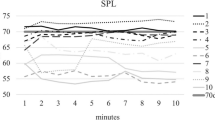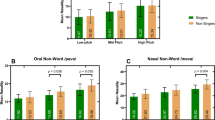Abstract
The objective of this study was to determine the relationship between lung volume (LV) conditions and vocal fold vibratory patterns using measurements of closed quotient (CQ), fundamental frequency (F0) and relative vocal intensity. Forty-three healthy and vocally untrained females were asked to produce the vowel /a/ following breathing instructions that cued for higher, habitual, or lower LV conditions. Closed quotient was measured by electroglottography (EGG) and analyzed using criterion-level method of 25%. An average of CQ, F0 and relative vocal intensity were obtained. No significant difference was observed in CQ between cued LV conditions; however, there was a trend for CQ to increase in the cued high LV condition. Relative vocal intensity and F0 differed significantly across all conditions with higher F0 and relative vocal intensity observed at the high LV condition. These findings suggested that the use of different cued LVs did not have a significant impact on CQ. This may have been due to (1) the phonatory task, (2) variability in responses to the breathing instructions between individuals, and (3) the measurement of CQ. However, F0 and relative vocal intensity were significantly influenced by the LV. This offers a possible alternative approach in cueing pitch and loudness in singing and voice therapy.




Similar content being viewed by others
References
Titze, I.R.: The physics of small-amplitude oscillation of the vocal folds. J. Acoust. Soc. Am. 83(4), 1536–1552 (1988)
Wanger, J., Clausen, J.L., Coates, A., Pedersen, O.F., Brusasco, V., Burgos, F., Casaburi, R., Crapo, R., Enright, P., van der Grinten, C.P., Gustafsson, P., Hankinson, J., Jensen, R., Johnson, D., Macintyre, N., McKay, R., Miller, M.R., Navajas, D., Pellegrino, R., Viegi, G.: Standardisation of the measurement of lung volumes. Eur. Respir. J. 26(3), 511–522 (2005). https://doi.org/10.1183/09031936.05.00035005
Iwarsson, J., Thomasson, M., Sundberg, J.: Effects of lung volume on the glottal voice source. J. Voice 12(4), 424–433 (1998)
Watson, P.J., Ciccia, A.H., Weismer, G.: The relation of lung volume initiation to selected acoustic properties of speech. J. Acoust. Soc. Am. 113(5), 2812–2819 (2003)
Iwarsson, J., Sundberg, J.: Effects of lung volume on vertical larynx position during phonation. J. Voice 12(2), 159–165 (1998)
Dromey, C., Ramig, L.O.: The effect of lung volume on selected phonatory and articulatory variables. J. Speech Lang. Hear. Res. 41(3), 491–502 (1998)
Collyer, S., Kenny, D.T., Archer, M.: The effect of abdominal kinematic directives on respiratory behaviour in female classical singing. Logop. Phon. Vocol. 34(3), 100–110 (2009). https://doi.org/10.1080/14015430903008780
Leanderson, R., Sundberg, J.: Breathing for singing. J. Voice 2(1), 2–12 (1988). https://doi.org/10.1016/S0892-1997(88)80051-1
Kiesgen, P.: Voice pedagogy: breathing. J. Sing. 62(2), 169–171 (2005)
Carding, P.N., Horsley, I.A.: An evaluation study of voice therapy in non-organic dysphonia. Eur. J. Disord. Commun. J. Coll. Speech Lang. Ther. Lond. 27(2), 137–158 (1992)
Ruddy, B.H., Davenport, P., Baylor, J., Lehman, J., Baker, S., Sapienza, C.: Inspiratory muscle strength training with behavioral therapy in a case of a rower with presumed exercise-induced paradoxical vocal-fold dysfunction. Int. J. Pediatr. Otorhinolaryngol. 68(10), 1327–1332 (2004). https://doi.org/10.1016/j.ijporl.2004.04.002
Solomon, N.P., Makashay, M.J., Kessler, L.S., Sullivan, K.W.: Speech-Breathing treatment and LSVT for a patient with hypokinetic-spastic dysarthria After TBI. J. Med. Speech-Lang. Pathol. 12(4), 213–219 (2004)
Xu, J.H., Ikeda, Y., Komiyama, S.: Bio-feedback and the yawning breath pattern in voice therapy: a clinical trial. Auris Nasus Larynx 18(1), 67–77 (1991)
Sapienza, C.M.: Respiratory muscle strength training applications. Curr. Opin. Otolaryngol. Head Neck Surg. 16(3), 216–220 (2008). https://doi.org/10.1097/MOO.0b013e3282fe96bd
Titze, I.R.: A framework for the study of vocal registers. J. Voice 2(3), 183–194 (1988). https://doi.org/10.1016/S0892-1997(88)80075-4
Steinhauer, K., Grayhack, J.P., Smiley-Oyen, A.L., Shaiman, S., McNeil, M.R.: The relationship among voice onset, voice quality, and fundamental frequency: a dynamical perspective. J. Voice 18(4), 432–442 (2004). https://doi.org/10.1016/j.jvoice.2004.01.006
Chernobelsky, S.: The use of electroglottography in the treatment of deaf adolescents with puberphonia. Logoped. Phon. Vocol. 27(2), 63–65 (2002). https://doi.org/10.1080/140154302760409275
Lim, J.Y., Lim, S.E., Choi, S.H., Kim, J.H., Kim, K.M., Choi, H.S.: Clinical characteristics and voice analysis of patients with mutational dysphonia: clinical significance of diplophonia and closed quotients. J. Voice 21(1), 12–19 (2007). https://doi.org/10.1016/j.jvoice.2005.10.002
Björkner, E., Sundberg, J., Cleveland, T., Stone, E., Skolan för datavetenskap och, k., Tal, m.o.h.T.M.H., Kth: Voice source differences between registers in female musical theater singers. J. Voice 20(2), 187–197 (2006). https://doi.org/10.1016/j.jvoice.2005.01.008
Roubeau, B., Chevrie-Muller, C., Arabia-Guidet, C.: Electroglottographic study of the changes of voice registers. Folia Phon. 39(6), 280–289 (1987)
Blomgren, M., Chen, Y., Ng, M.L., Gilbert, H.R.: Acoustic, aerodynamic, physiologic, and perceptual properties of modal and vocal fry registers. J. Acoust. Soc. Am. 103(5 Pt 1), 2649–2658 (1998)
La, F.M., Sundberg, J.: Contact quotient versus closed quotient: a comparative study on professional male singers. J. Voice 29(2), 148–154 (2015). https://doi.org/10.1016/j.jvoice.2014.07.005
Herbst, C., Ternström, S.: A comparison of different methods to measure the EGG contact quotient. Logop. Phoniatr. Vocol. 31(3), 126–138 (2006). https://doi.org/10.1080/14015430500376580
Kania, R.E., Hans, S., Hartl, D.M., Clement, P.: Variability of electroglottographic glottal closed quotients. Arch. Otolaryngol. Head Neck Surg. 130(3), 349 (2004)
Verdolini, K., Druker, D.G., Palmer, P.M., Samawi, H.: Laryngeal adduction in resonant voice. J. Voice 12(3), 315–327 (1998). https://doi.org/10.1016/S0892-1997(98)80021-0
Kankare, E., Laukkanen, A.-M., Ilomäki, I., Miettinen, A., Pylkkänen, T.: Electroglottographic contact quotient in different phonation types using different amplitude threshold levels. Logop. Phon. Vocol. 37(3), 127–132 (2012). https://doi.org/10.3109/14015439.2012.664656
Henrich, N., Alessandro, C., Doval, B., Castellengo, M.: On the use of the derivative of electroglottographic signals for characterization of nonpathological phonation. J. Acoust. Soc. Am. 115(3), 1321–1332 (2004). https://doi.org/10.1121/1.1646401
Paul, N., Kumar, S., Chatterjee, I., Mukherjee, B.: Electroglottographic parameterization of the effects of gender, vowel and phonatory registers on vocal fold vibratory patterns: an Indian perspective. Indian J. Otolaryngol. Head Neck Surg. 63(1), 27–31 (2011). https://doi.org/10.1007/s12070-010-0099-0
Henrich, N., d’Alessandro, C., Doval, B., Castellengo, M.: Glottal open quotient in singing: Measurements and correlation with laryngeal mechanisms, vocal intensity, and fundamental frequency. J. Acoust. Soc. Am. 117(3), 1417–1430 (2005). https://doi.org/10.1121/1.1850031
Stathopoulos, E.T., Sapienza, C.: Respiratory and laryngeal function of women and men during vocal intensity variation. J. Speech Hear. Res. 36(1), 64–75 (1993)
Kitzing, P., Sonesson, B.: A photoglottographical study of the female vocal folds during phonation. Folia Phoniatrica 26(2), 138–149 (1974)
Sundberg, J.E., Leanderson, R., von Euler, C.: Activity relationship between diaphragm and cricothyroid muscles. J. Voice 3(3), 225–232 (1989). https://doi.org/10.1016/S0892-1997(89)80004-9
Deary, I.J., Wilson, J.A., Carding, P.N., MacKenzie, K.: VoiSS: a patient-derived voice symptom scale. J. Psychosom. Res. 54(5), 483–489 (2003). https://doi.org/10.1016/S0022-3999(02)00469-5
Fairbanks, G.: Voice and Articulation Drillbook, 2nd edn. Harper & Row, New York (1960)
Hirano, M.: Clinical Examination of Voice. Book, Whole, vol. 5. Springer-Verlag, Wien (1981)
AKG Acoustics. https://www.akg.com/Microphones/Headset%20Microphones/C520.html. Accessed June 2018
Ambulatory Monitoring Inc. http://www.ambulatory-monitoring.com/inductotrace.html (2018). Accessed June 2018
Glottal Enterprises: Electroglottographs. http://www.glottal.com/Electroglottographs.html (2018). Accessed June 2018
ADInstruments: PowerLab. https://www.adinstruments.com/products/powerlab (2018). Accessed June 2018
ADInstruments: LabChart. https://www.adinstruments.com/products/labchart. Accessed June 2018
Iwarsson, J., Thomasson, M., Sundberg, J.: Lung volume and phonation: a methodological study. Logoped. Phon. Vocol. 21(1), 13–20 (1996). https://doi.org/10.3109/14015439609099198
Glottal Enterprises: PhaseComp Software. http://www.glottal.com/PhaseComp.html (2018). Accessed June 2018
Boersma, P., Weenink, D.: Praat: doing phonetics by computer. http://www.fon.hum.uva.nl/praat/. January, 2018
Shrout, P.E., Fleiss, J.L.: Intraclass correlations: uses in assessing rater reliability. Psychol. Bull. 86(2), 420–428 (1979)
Koo, T.K., Li, M.Y.: A guideline of selecting and reporting intraclass correlation coefficients for reliability research. J. Chiropr. Med. 15(2), 155–163 (2016). https://doi.org/10.1016/j.jcm.2016.02.012
Chasaide, A.N., Gobl, C.: Contextual variation of the vowel voice source as a function of adjacent consonants. Lang. Speech 36(Pt 2–3), 303–330 (1993). https://doi.org/10.1177/002383099303600310
Löfqvist, A., Baer, T., McGarr, N.S., Story, R.S.: The cricothyroid muscle in voicing control. J. Acoust. Soc. Am. 85(3), 1314–1321 (1989)
Hoole, P., Bombien, L.: Laryngeal–oral coordination in mixed-voicing clusters. J. Phon. 44, 8–24 (2014). https://doi.org/10.1016/j.wocn.2014.02.004
Hanson, H.M., Stevens, K.N.: A quasiarticulatory approach to controlling acoustic source parameters in a Klatt-type formant synthesizer using HLsyn. J. Acoust. Soc. Am. 112(3 Pt 1), 1158–1182 (2002). https://doi.org/10.1121/1.1498851
Löfqvist, A.: Acoustic and aerodynamic effects of interarticulator timing in voiceless consonants. Lang. Speech 35(1–2), 15 (1992)
Cho, T., Ladefoged, P.: Variation and universals in VOT: evidence from 18 languages. J. Phon. 27(2), 207–229 (1999). https://doi.org/10.1006/jpho.1999.0094
Hutters, B.: Vocal fold adjustments in Danish voiceless obstruent production. Ann. Rep. Inst. Phon. Univ. Cph. 18, 293–385 (1984)
Orlikoff, R.F., Deliyski, D.D., Baken, R.J., Watson, B.C.: Validation of a glottographic measure of vocal attack. J. Voice 23(2), 164–168 (2009). https://doi.org/10.1016/j.jvoice.2007.08.004
Mathieson, L.: Greene and Mathieson’s the Voice and its Disorders. Book, Whole, vol. 6th. Wiley, Hoboken (2013)
Kochis-Jennings, K.A., Finnegan, E.M., Hoffman, H.T., Jaiswal, S.: Laryngeal muscle activity and vocal fold adduction during chest, chestmix, headmix, and head registers in females. J. Voice 26(2), 182–193 (2012). https://doi.org/10.1016/j.jvoice.2010.11.002
Hirano, M., Ohala, J., Vennard, W.: The function of laryngeal muscles in regulating fundamental frequency and intensity of phonation. J. Speech Lang. Hear. Res. 12(3), 616–628 (1969)
Sulter, A.M., Albers, F.W.: The effects of frequency and intensity level on glottal closure in normal subjects. Clin. Otolaryngol. Allied Sci. 21(4), 324–327 (1996)
Zhang, Z.: Mechanics of human voice production and control. J. Acoust. Soc. Am. 140(4), 2614 (2016). https://doi.org/10.1121/1.4964509
Sundberg, J.: Vocal fold vibration patterns and phonatory modes. Q. Prog. Status Rep. 35(2–3), 69–80 (1994)
Roark, R.M., Watson, B.C., Baken, R.J., Brown, D.J., Thomas, J.M.: Measures of vocal attack time for healthy young adults. J. Voice 26(1), 12–17 (2012). https://doi.org/10.1016/j.jvoice.2010.09.009
Han, J.N., Stegen, K., Cauberghs, M., Van de Woestijne, K.P.: Influence of awareness of the recording of breathing on respiratory pattern in healthy humans. Eur. Respir. J. 10(1), 161–166 (1997). https://doi.org/10.1183/09031936.97.10010161
Mitchell, H.L., Hoit, J.D., Watson, P.J.: Cognitive-linguistic demands and speech breathing. J. Speech Hear. Res. 39(1), 93–104 (1996)
Plant, R.L.: The interrelationship of subglottic air pressure, fundamental frequency, and vocal intensity during speech. J. Voice Off. J. Voice Found. 14(2), 170–177 (2000). https://doi.org/10.1016/S0892-1997(00)80024-7
Rothenberg, M., Mahshie, J.J.: Monitoring vocal fold abduction through vocal fold contact area. J. Speech Lang. Hear. Res. 31(3), 338–351 (1988)
Milstein, C.F.: Laryngeal function associated with changes in lung volume during voice and speech production in normal speaking women. Ph.D., The University of Arizona (1999)
Iwarsson, J.: Effects of inhalatory abdominal wall movement on vertical laryngeal position during phonation. J. Voice 15(3), 384–394 (2001). https://doi.org/10.1016/S0892-1997(01)00040-6
Sundberg, J.E.: Vocal fold vibration patterns and modes of phonation. Folia Phomiatrica et Logopaedica 47(4), 218–228 (1995)
Titze, I.R.: On the relation between subglottal pressure and fundamental frequency in phonation. J. Acoust. Soc. Am. 85(2), 901–906 (1989)
Zhang, Z.: Regulation of glottal closure and airflow in a three-dimensional phonation model: implications for vocal intensity control. J. Acoust. Soc. Am. 137(2), 898–910 (2015). https://doi.org/10.1121/1.4906272
Stathopoulos, E.T.: Relationship between intraoral air pressure and vocal intensity in children and adults. J. Speech Hear. Res. 29(1), 71–74 (1986)
Rossing, T.D.: Springer Handbook of Acoustics. Book, Whole. Springer, New York (2007)
Brogan, F.A., Tonndorf, J., Washburn, D.D.: Auditory difference limen of intensity in normal hearing subjects. A. M. A. Arch. Otolaryngol. 62(3), 292–305 (1955). https://doi.org/10.1001/archotol.1955.03830030058011
Hirano, M., Vennard, W., Ohala, J.: Regulation of register, pitch and intensity of voice. An electromyographic investigation of intrinsic laryngeal muscles. Folia Phon. 22(1), 1–20 (1970)
Rochet-Capellan, A., Fuchs, S.: Changes in breathing while listening to read speech: the effect of reader and speech mode. Front. Psychol. 4, 906 (2013). https://doi.org/10.3389/fpsyg.2013.00906
Gallego, J., Perruchet, P.: Effect of practice on the voluntary control of a learned breathing pattern. Physiol. Behav. 49(2), 315–319 (1991). https://doi.org/10.1016/0031-9384(91)90049-T
Hixon, T.J., Hoit, J.D.: Evaluation and Management of Speech Breathing Disorders: Principles and Methods, Book, Whole, vol. 1st. Redington Brown, Tucson (2005)
Acknowledgements
This study was supported by the 2013 Education Grant from the Australian Acoustical Society. We would also like to acknowledge the support of the Dr Liang Voice Program at the University of Sydney.
Author information
Authors and Affiliations
Corresponding author
Rights and permissions
About this article
Cite this article
Yeo, S., Lee, R., McCabe, P. et al. Effects of Different Lung Volume Conditions on Closed Quotient, Vocal Fundamental Frequency and Relative Intensity in Vocally Untrained Female Speakers. Acoust Aust 46, 339–347 (2018). https://doi.org/10.1007/s40857-018-0144-9
Received:
Accepted:
Published:
Issue Date:
DOI: https://doi.org/10.1007/s40857-018-0144-9




